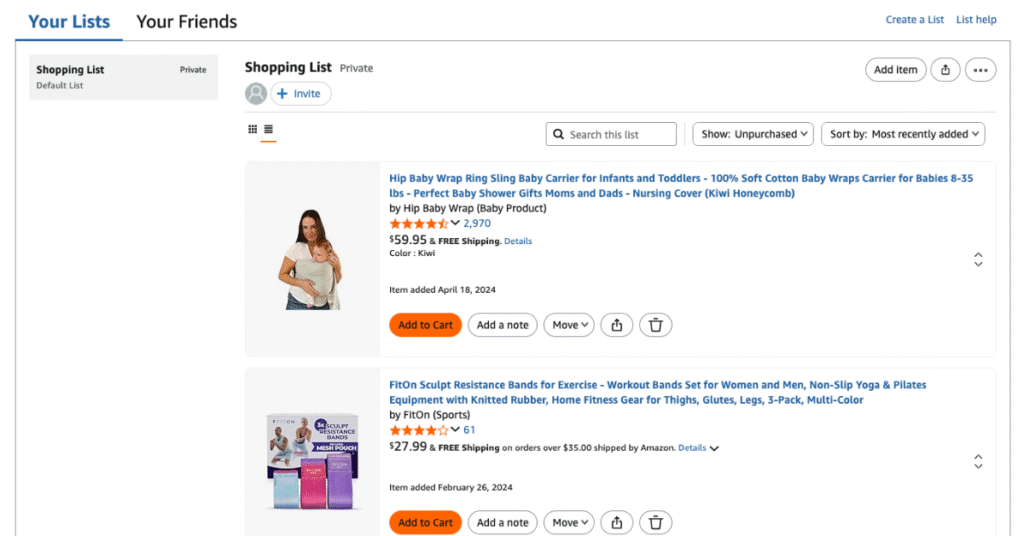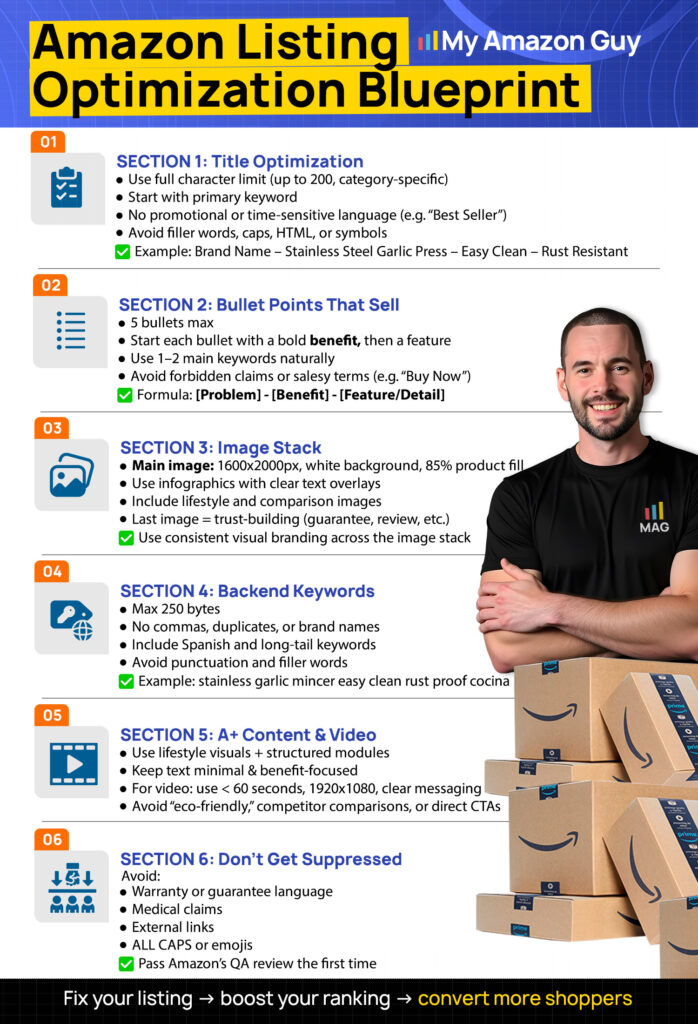
If you’re still under the impression that an Amazon Wish List is only useful for shoppers, it might be time to rethink that. An Amazon Wish List can also be a powerful sales tool for sellers when used strategically.
Many shoppers use the Amazon Wish List to keep track of products they plan to buy later or hope to receive as gifts. It also helps them organize favorites and compare items without having to add them to their cart.
However, not many sellers realize that this feature can also serve as a goldmine of insights. That’s a missed opportunity, considering the Wish List reflects real buyer intent and trends sellers can use to shape their strategies.
In this article, our Amazon agency will discuss how the Amazon Wish List works and why it’s a valuable tool for sellers looking to boost sales and understand buyer intent. We will also share practical strategies to help sellers use Wish List data to improve visibility, plan campaigns, and convert shopper interest into real sales.
Table of Contents
Turn Buyer Interest Into Real Sales
Use Amazon Wish List data to identify what shoppers want and boost conversions effortlessly.
What Is the Amazon Wish List and How Does It Work?
An Amazon Wish List is a built-in feature that lets shoppers save and organize products they want to buy later. It serves as a personal shopping board where customers can easily keep track of items without needing to purchase them right away.
How the Amazon Wish List Works for Buyers
With over 600 million products available worldwide, Amazon shoppers are constantly browsing through endless options. Having a Wish List lets them easily keep track of the items they’re interested in buying later without losing them in the mix.
By clicking “Add to List” on any product page, shoppers can save products, add notes, and even organize them by category or occasion. It’s also handy for tracking price changes and sharing lists with friends and family during gifting seasons.
How the Amazon Wish List Works for Sellers
While sellers can’t view who specifically adds their products to a Wish List, they can still benefit from the visibility those products gain. When items are frequently saved, Amazon’s algorithm takes note, which can help boost rankings and even land products in the “Most Wished For” category.
Public Wish Lists also give sellers valuable insight into buyer intent and emerging product trends. By tracking which products are most frequently added to Amazon Wish Lists, sellers can refine their pricing, ad strategy, and inventory planning to align with what customers actually want.
Why Amazon Wish List Matters for Sellers
For any e-commerce business, data is power since it helps sellers understand buyer intent and forecast demand more accurately. An Amazon Wish List contributes to this by revealing what products customers are genuinely interested in, even before they make a purchase.
Other than that, Amazon Wish Lists are also important for sellers because of the following:
1. Boosts Product Visibility
Products frequently added to Wish Lists gain more visibility in Amazon’s search results and recommendations. This signals to Amazon’s algorithm that the item is popular, increasing the chances of appearing in front of new potential buyers.
2. Drives Organic Traffic
When thousands of shoppers save a product, Amazon recognizes that it’s in demand and surfaces it to others through “Most Wished For” lists. This can attract a steady stream of organic traffic without additional ad spend.
3. Builds Social Proof and Credibility
When shoppers add a product to their Wish List, it acts like a personal endorsement. The more a product appears on multiple lists, the more trust it gains with other buyers browsing on Amazon.
4. Encourages Word-of-Mouth Marketing
Since 92% of people trust recommendations from friends and family more than any form of advertising, shared Wish Lists can be a goldmine for sellers. When shoppers share their lists, your products get free exposure to new audiences, driving organic visibility and brand awareness without extra ad spend.
5. Provides Insight Into Customer Preferences
Monitoring which items end up on Wish Lists helps sellers understand what customers are genuinely interested in. These insights can guide your pricing, keyword strategy, and product development.
6. Helps With Inventory and Seasonal Planning
If your product is being added to many Wish Lists but not purchased yet, it may be a sign of seasonal demand. This data can help you plan stock levels and prepare for upcoming sales periods more effectively.
7. Creates Opportunities for Promotions and Retargeting
Items on a buyer’s Wish List are already halfway to a purchase. Running discounts or sending price-drop alerts for these products can nudge shoppers to finally complete the sale.
8. Supports Upselling and Cross-Selling
By analyzing products that often appear together on Wish Lists, sellers can identify complementary items to bundle or promote together. This strategy helps boost average order value and strengthens product positioning.
Get Expert Help From Our Amazon Agency
Our team can help you optimize listings, improve visibility, and grow your brand faster.
How Can Sellers Effectively Use the Amazon Wish List
There are various ways sellers can use an Amazon Wish List to be useful for their marketing and product growth strategies. When used the right way, this feature can provide valuable insights into customer intent, help sellers plan promotions, and even boost long-term sales performance.
1. Optimize Product Listings for Wish List Adds
You can’t expect shoppers to save your products if your listings don’t catch attention. Make sure your titles, bullet points, and descriptions are keyword-optimized, easy to read, and highlight what makes your product valuable.
Use clear, high-resolution photos and videos that show your product in use. Visual content can help customers imagine owning the product, making them more likely to save it for later.
2. Offer Incentives and Promotions
Give shoppers a reason to hit that “Add to List” button. Offering exclusive deals, coupons, or limited-time discounts can motivate customers to save your products for future purchases.
You can even promote events like “Wish List Sales” where shoppers who’ve saved your products get notified of special price drops. This creates a sense of urgency and helps convert wish list interest into actual sales.
3. Use Email Marketing and Social Media to Encourage Wish Listing
Promote your products on email campaigns or social posts by reminding customers to add them to their Amazon Wish Lists. Position your products as perfect gift ideas or “must-haves” for specific seasons or occasions.
Highlight customer reviews or testimonials in your emails and posts. This builds trust and increases the likelihood that shoppers will bookmark your products for later purchase.
4. Track and Analyze Wish List Data
Pay close attention to which of your products appear most frequently on Amazon Wish Lists. These items often reflect future buying trends and can help you prioritize marketing and inventory decisions.
Use this data to refine your pricing or identify underperforming listings. For example, if an item has a high “save” rate but low conversion, it could mean your price or offer needs adjustment.
5. Focus on Top-Performing and Trending Products
Products that show up often on public Wish Lists indicate strong buyer interest. Double down on those listings with more ad spend, enhanced content, and improved placement on your Amazon Storefront.
You can also create bundles or upsell related items that complement your best-performing Wish List products. This strategy not only boosts your conversion rate but also increases average order value.
6. Plan Seasonal Campaigns Around Wish List Activity
The Amazon Wish List can serve as an early indicator of what shoppers want during major sales seasons. By tracking which products are being saved in the months leading up to events like Prime Day or Christmas, you can plan your stock and campaigns more effectively.
Consider offering gift wrapping, personalized messages, or bundle deals for high-demand wish-listed items. These small additions can make your products more appealing as holiday or event gifts.
7. Use Wish Lists for Cross-Selling and Upselling Opportunities
If you notice shoppers adding complementary items to their lists, that’s your cue to create product bundles or “frequently bought together” offers. This helps you tap into existing buying intent and encourage larger purchases.
You can also recommend related products through ads or product inserts to help customers discover more from your catalog. The goal is to turn one saved item into multiple sales opportunities.
8. Treat Wish Lists as Market Research Tools
Wish Lists aren’t just for shoppers; they’re also a goldmine for understanding trends. Monitor what customers are saving across different categories to spot rising product demand or market gaps.
This insight can guide your product development, pricing, or expansion into new niches. Sellers who pay attention to Wish List trends often stay ahead of competitors and make smarter inventory decisions.
FAQs About Amazon Wish List
Can Amazon sellers make an Amazon Wish List?
Yes. Amazon sellers can make an Amazon Wish List the same way buyers do, which is by adding items to a personal or public list. While sellers can’t directly see who added their products to a wish list, creating one themselves can help track trends, competitor products, or gift ideas for customers.
How do I create a Wish List on Amazon as a seller?
To create a Wish List, go to your Amazon account, click on “Accounts & Lists”, then select “Create a List”. You can name it, adjust privacy settings, and start adding products, including your own listings, to monitor performance or plan marketing strategies.
Why should sellers pay attention to Amazon Wish Lists?
Amazon Wish Lists give insight into what shoppers want but haven’t yet purchased. When you analyze which products shoppers frequently add, you can adjust pricing, create targeted discounts, and improve listings to increase conversions.
Turning Shoppers’ Wish Lists into Your Sales Strategy
While the Amazon Wish List was originally designed for customers to save and organize products they love, it’s also a goldmine for sellers who know how to use it strategically. By paying attention to what shoppers are saving, sellers can identify demand trends, fine-tune listings, and uncover new opportunities to grow their brand visibility.
Through this guide, we hope sellers now have a better understanding of how the Amazon Wish List works, why it matters, and how to turn it into a valuable sales and marketing tool. Every “Add to List” is a hint about what shoppers want next, and smart sellers use that data to plan their next move.
Need help turning buyer intent into measurable sales growth? Contact our full-service Amazon agency today and let our experts help you optimize listings, improve visibility, and scale your business faster.
Stop Guessing What Shoppers Want
Let our experts help you turn customer insights into profitable growth opportunities.






